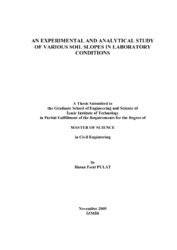Please use this identifier to cite or link to this item:
https://hdl.handle.net/11147/3020Full metadata record
| DC Field | Value | Language |
|---|---|---|
| dc.contributor.advisor | Egeli, İsfendiyar | en |
| dc.contributor.author | Pulat, Hasan Fırat | - |
| dc.date.accessioned | 2014-07-22T13:50:43Z | - |
| dc.date.available | 2014-07-22T13:50:43Z | - |
| dc.date.issued | 2009 | en |
| dc.identifier.uri | http://hdl.handle.net/11147/3020 | - |
| dc.description | Thesis (Master)--Izmir Institute of Technology, Civil Engineering, Izmir, 2009 | en |
| dc.description | Includes bibliographical references (leaves: 134-147) | en |
| dc.description | Text in English; Abstract: Turkish and English | en |
| dc.description | xviii, 147 leaves | en |
| dc.description.abstract | Slope stability is a significant subject of geotechnical engineering. Slope failures triggered by rainfall are causing considerable damage and loss of life every year throughout the world. Especially at dry seasons when the rainfall is scarce, the ground can develop considerable amount of suction and this improves the shear strength of the soil. In rainy season, when rainfall infiltrates into ground, suction decreases, while the shear strength also reduces, which may lead to slope instability. One of the principle objectives of this study is to represent the development of soil-water interaction modeling system (SWIMS) at IYTE. Using this system; effects of 3 different parameters, such as: initial water content, soil density, slope angle on modelling unsaturated slope stability were studied. Moreover, effects of infiltration on slope stability in shallow landslides, where it is assumed that the ground water tables are located at significant depths, were examined.In this thesis study, 12 main slope model experiments were completed in laboratory conditions, using Soil-Water Interaction Modelling System (SWIMS) by varying 3 different parameters. Result of studies shows that slope angle is the most important parameter affecting slope stability. Furthermore, parameters such as; soil density, degree of relative compaction of soil and initial water content affects slope stability, while these parameters also affect slope surface erosion and infiltration depths. In addition to experimental studies conducted in laboratory conditions with the 12 main slope model experiments, slope stability analyses to find FOS were performed by using Plaxis V9 (2D) finite element program (FEM), which uses shear strength reduction (SSR) technique and infiltration analyses using the Plaxflow module to model the rainwater infiltration into slope soil were performed. The FEM analyses show conforming results with the actual observations made using the tested soil model in laboratory conditions. | en |
| dc.language.iso | en | en_US |
| dc.publisher | Izmir Institute of Technology | en |
| dc.rights | info:eu-repo/semantics/openAccess | en_US |
| dc.subject.lcc | TA749 .P98 2009 | en |
| dc.subject.lcsh | Slopes (Soil mechanics)--Stability | en |
| dc.subject.lcsh | Soil mechanics | en |
| dc.subject.lcsh | Soil stabilization | en |
| dc.title | An experimental and analytical study of various soil slopes in laboratory conditions | en_US |
| dc.type | Master Thesis | en_US |
| dc.institutionauthor | Pulat, Hasan Fırat | - |
| dc.department | Thesis (Master)--İzmir Institute of Technology, Civil Engineering | en_US |
| dc.relation.publicationcategory | Tez | en_US |
| item.languageiso639-1 | en | - |
| item.fulltext | With Fulltext | - |
| item.grantfulltext | open | - |
| item.openairecristype | http://purl.org/coar/resource_type/c_18cf | - |
| item.cerifentitytype | Publications | - |
| item.openairetype | Master Thesis | - |
| Appears in Collections: | Master Degree / Yüksek Lisans Tezleri | |
Files in This Item:
| File | Description | Size | Format | |
|---|---|---|---|---|
| T000035.pdf | MasterThesis | 3.44 MB | Adobe PDF |  View/Open |
CORE Recommender
Page view(s)
132
checked on Jul 15, 2024
Download(s)
116
checked on Jul 15, 2024
Google ScholarTM
Check
Items in GCRIS Repository are protected by copyright, with all rights reserved, unless otherwise indicated.